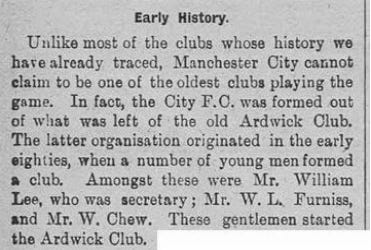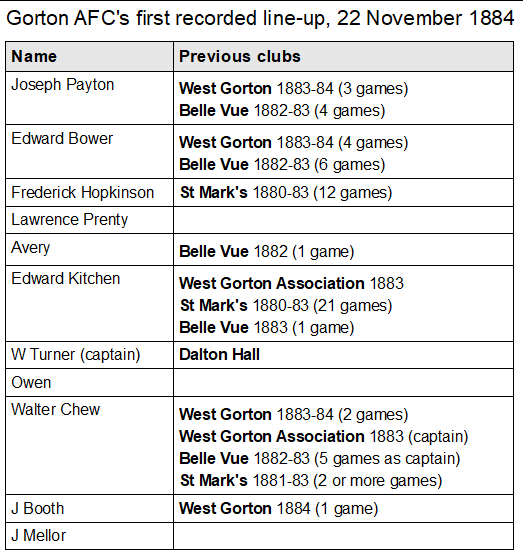The Birth of Football and the Origins of Manchester City
Part Thirteen: The Creation of Gorton AFC
By 1884 association football had established itself as a popular pastime in Manchester. Ten new clubs were formed in the city and its surrounding areas during the 1883-84 season, bringing the total to nearly thirty.
But the Manchester game was also becoming an increasingly rowdy affair. And on 22 March 1884, in a match between West Gorton and newly-formed Gorton Villa at Clemington Park, it suffered its first fatality.
According to the Manchester Courier, a Gorton Villa player named William Lennon 'was dribbling the ball along the field, when he was charged by one of the opposite side, a youth named Manning'. The 24-year-old Lennon immediately 'complained of feeling great pain in his abdomen' and left the game. He died three days later in Manchester Infirmary, the result of a ruptured bowel. The practice of “charging” was already a controversial one which, according to the Gorton Reporter, ‘frequently resulted in fatal accidents’. Its report on Lennon's death noted that
'The dangers of football have this year been made more evident than ever. Scarcely a week has passed but there has been an accident, several of which have terminated fatally'.
At the player's inquest 'the jury were so impressed with the danger attended on 'charging' which the Association rules permit, that they recorded their recommendation that the rule be abolished'.
But behaviour off the pitch was also attracting the scorn of the Manchester press. On 8 April the Manchester Courier's football correspondent, “Veteran”, declared that
'Something must be done, moreover, to stamp out the rowdyism which of late has disgraced the playing of football, and notably of association football, in this part of the world.'
As well as the mobbing of referees by spectators, and 'stoning and otherwise maltreating players', “Veteran” was particularly critical of fans who excitedly yelled out 'that the absolute annihilation of the whole opposing team would cause no actually poignant grief to him'.
Possibly in response to increasing calls for regulation, in September the Manchester & District Football Association was formed. It had an initial membership 16 clubs: Manchester Association, Manchester Arcadians, Dalton Hall, Greenheys, Levenshulme, Hurst, Hurst Park Road, Hurst Brook Olympic, Hurst Clarence, Pendleton Olympic, Haughton Dale, West Gorton, Eccles, West Manchester, Thornham and Newton Heath LYR.
The standard of football played in Manchester at this time was still a million miles away from that of the Lancashire mill towns. In March 1884 Blackburn Rovers had won the FA Cup, the second successive time a working-class side from the town had lifted the trophy.
Manchester’s sole representative in the FA Cup that season, Manchester Association, had been beaten 15-0 by Queen's Park of Glasgow in the second round. No Manchester club entered the 1884-85 FA Cup, but in October eight of the area's clubs—Hurst Park Road, Heywood, Greenheys, Newton Heath, Eccles, Manchester AFC, Levenshulme and Hurst Clarence—took part in the first round of the Lancashire FA Cup. Seven of them lost, scoring just four goals between them and conceding 46. Only Newton Heath's 4-0 win over Haydock Temperance salvaged Manchester pride.
But the promise of a Manchester Challenge Cup competion brought the prospect of improvement, and the hope that football could challenge rugby as the city's main winter sport. Soon after the announcement of the new competition, the Manchester FA accepted a new member.
On 25 October 1884, the Gorton Reporter revealed that
'The members of the old West Gorton Association Football Club have pulled together, and, with the assistance of a few other players, have formed a new club under the name of “Gorton Association”. A suitable ground has been secured near Belle Vue station. Mr E Kitchen, Railway Cottages, Longsight has been appointed secretary. He is staging matches for both first and second teams.’
So was Gorton Association a ‘new club’, as the Gorton Reporter states, or more a continuation of the West Gorton / St Mark’s side?
Unfortunately, as the previous instalment shows, the evidence is far from clear.
The first written account of the club's early days, from the December 1898 Golden Penny magazine (below) places City's formation to the ‘early eighties’, and names William Lee, W L Furniss and W Chew as the men who started the club.
In a second history of the club from November 1900, the Golden Penny revised the formation date to just ‘the eighties’ and called Lee, Furniss and Chew the ‘prime movers’ in the club’s creation.
The naming of Lee as club secretary is puzzling. This is probably the William Lee listed in the 1881 census as a ‘warehouse boy’ who lived a few doors down from Water and William Chew at 21 Elizabeth Street. But as Lee is not mentioned in any Gorton AFC accounts, it’s possible that he was the first secretary of West Gorton Association in 1882-83 season, which the Golden Penny is using as the club’s starting point.
But perhaps the best indicator of the club’s heritage is the first recorded line-up, for the game against Heywood St James on 22 November. Four of the side had played for West Gorton (which appears to be Belle Vue Rangers under a different name) a month earlier, and three of those had been regulars for Belle Vue Rangers in the 1882-83 season. Only two had played regularly for St Mark's, while four had no known connection to any West Gorton club.
This suggests that this was indeed a new club, rather than a revival of an old one. But whatever Gorton AFC’s lineage, what is clear is that this is the club that we now know as Manchester City.
And of course, this being City, it wasn’t long before it suffered its first crisis.
My book on City’s origins, A Man’s Game, is available on Amazon here.
What was the first song at City? Why did Steve Coppell resign? Did City have a “Fifth Column”? Did the IRA try to burn down Hyde Road? Who started the “banana craze”? And what was Maine Road's Scoreboard End called before there was a scoreboard?
All these questions—and more—are answered in my latest book, available on Amazon here.
You can subscribe for free, below, and have the latest stories sent straight to your inbox.





